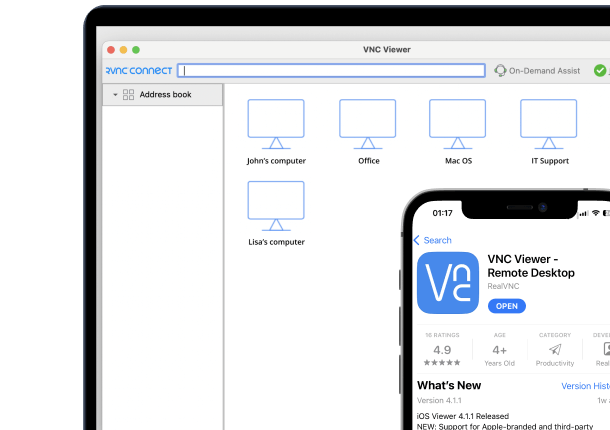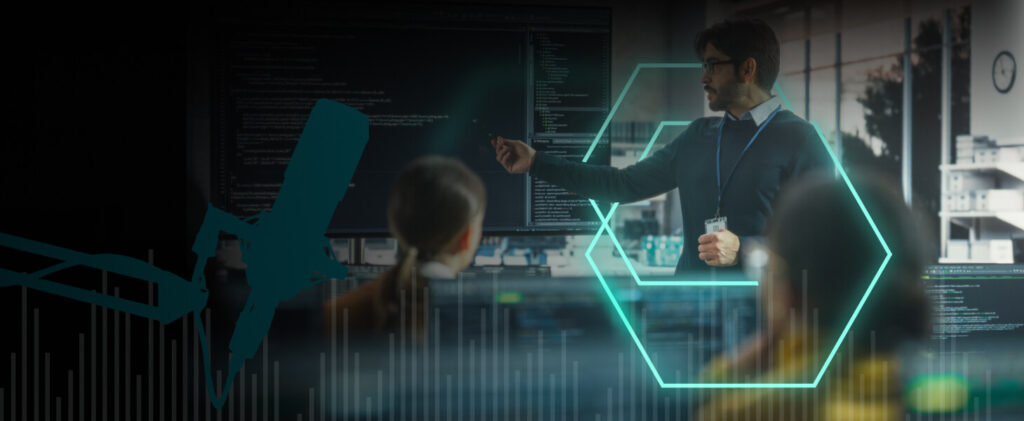This article is updated for April 2022.
What is IoT?
The Internet of Things (IoT) consists of many devices linked to the internet, returning real-time data for diagnostics, maintenance, and planning. These can be cameras, industrial sensors, home appliances, cars, and many other tools.

However, the proliferation of these devices presents challenges for organizations in areas like maintenance and security. Some of these challenges are logistical. Remote access, including accessing IoT devices with secure access solutions, can help address these problems in many ways, which we’ll discuss in this blog post.
Common Applications of IoT in Key Industries
The Internet of Things (IoT) is transforming numerous industries by enhancing operational efficiency, optimizing resource management, and providing real-time insights. Some of the most impactful applications of IoT include:

Smart buildings
IoT devices in smart buildings allow for improved energy consumption monitoring, optimal facilities management, and automation of essential services like heating, lighting, and security. These devices help building managers ensure systems are running efficiently.
Buildings equipped with IoT devices promise more innovative data monitoring for issues such as energy consumption, water usage, environmental statistics, and infrastructure failures. With numerous IoT devices installed throughout a building, sometimes in hard-to-reach locations, a reliable and secure remote access solution is essential for monitoring and managing the ‘health’ of the building and its occupants. Managing IoT devices remotely is crucial for ensuring operational efficiency and addressing any issues promptly.
The ability to connect remotely to a device from anywhere allows you to monitor what is happening in real time quickly and resolve any issues. It also allows you to perform maintenance, such as software or firmware upgrades, without physically accessing the devices.

Smart agriculture
IoT devices like sensors are being used in agriculture to monitor soil moisture and nutrient levels, livestock health, control crops’ irrigation and fertilizer application, and even remotely operate farm machinery. By using remote access, farmers can regularly retrieve data about their crops and livestock to make decisions that will increase their yields and profits.
A reliable remote access solution allows workers to perform many technical duties remotely, like regular system maintenance or controlling machinery. When travel is necessary, remote access is a helpful technology that helps off-site employees stay connected regardless of their physical location, minimizing disruptions and improving working efficiency.

Smart factories
In industrial settings, IoT devices play a crucial role in optimizing production processes, reducing downtime, and predicting maintenance needs. Remote access to IoT systems allows factory managers to monitor machine performance, troubleshoot issues, and perform software updates without needing on-site visits, significantly increasing efficiency.
While on-site service calls may still be necessary for certain machinery, many maintenance tasks—such as system monitoring, diagnostics, and software upgrades—can now be handled remotely. This minimizes disruption, reduces travel costs, and ensures that systems stay up-to-date with minimal downtime. As a result, smart factories can maintain higher production uptime, offer more efficient customer service, and lower overall maintenance costs.

Smart business
In the modern world of just-in-time delivery, IoT devices embedded throughout the supply chain can allow consignments of goods to be tracked in real-time from supermarket warehouse to shop and from shop to customer, using remote access software. It enables companies to manage all supply chain stages and identify and respond to any problems before affecting the business.
In the retail sector, IoT technology has a role in analyzing real-time sales of goods and monitoring changes and trends to allow a company to respond more flexibly to rapidly changing demand and tight deadlines.
Remote access to IoT data across multiple locations and retail outlets allows you to build a comprehensive picture of retail activity locally, nationally, or even globally. Organizations can also use this information to assess the effectiveness of advertising campaigns.
Changes in consumer behavior and sales can be potentially traced to specific campaigns, leading to more targeted and effective use of advertising budgets. Data accessed remotely across multiple sites can be used for more accurate long-term planning, improving efficiency in all business areas.

Smart cities
IoT devices play a critical role in managing urban infrastructure, such as traffic lights, water systems, and utility grids. Remote access solutions help city managers optimize traffic flow, reduce energy consumption, and monitor public safety systems, all in real time. Remote devices that can enable these advances include communication infrastructure to monitor substations and transmission equipment.
By using remote access software to access these devices, utility companies can fine-tune the performance of the energy grid, prevent outages, and help restore power quickly if they happen. They can also allow customers to manage their energy usage, even down to the level of individual networked devices.
Other smart city applications include public safety and traffic management, intelligent lighting, and water treatment services.
In the smart city, remote access solutions have a role in monitoring and maintaining the status of all these systems. Having round-the-clock remote access to information from sensors and cameras can help reduce traffic congestion, optimize transport networks, and keep the availability of utilities throughout the city.
Why is IoT Remote Access Important?
IoT remote access is key to managing and maintaining IoT devices. The ability to remotely access these various networks of devices from anywhere gives you several benefits that boost overall IoT system performance and security.
Here are some key benefits of IoT remote access:
Real-Time Monitoring and Rapid Response
Remote access enables continuous, real-time, remote monitoring of IoT devices, allowing organizations to detect issues immediately. Whether it’s a malfunctioning industrial machine or a smart city sensor reporting anomalies, rapid identification of problems minimizes downtime and ensures that issues can be fixed promptly. Predictive maintenance further enhances this capability by identifying potential failures before they occur, optimizing resource use, and preventing costly disruptions.
Data Collection and Analysis for Better Decision-Making
IoT devices generate vast amounts of valuable data, from performance metrics to environmental readings. Remote access facilitates the retrieval and analysis of this data, empowering businesses to make data-driven decisions. This leads to improved device performance, operational efficiency, and even enhanced customer experiences by offering real-time insights into service delivery and usage patterns.
Reduced Operational Costs
IoT remote access drastically reduces operational costs by eliminating the need for on-site visits for device troubleshooting or maintenance. Organizations save on labor, travel, and potential production downtime while maintaining their devices with greater speed and efficiency.
In industries with geographically dispersed assets, such as agriculture and energy, for example, this can result in significant cost savings.
Enhanced Security for Connected Devices
As the number of connected IoT devices grows, so do security concerns. Remote access solutions that incorporate best practices, such as multi-factor authentication (MFA) and Secure Shell (SSH) protocols, protect these devices from cyber threats.
This ensures that both data and network infrastructure remain safe, even when accessed remotely. Properly secured remote access is critical in protecting sensitive information and maintaining the integrity of IoT systems.
Managing Third-Party Access
Manufacturers must manage remote access by third parties and employees to reduce security risks, which is a crucial aspect of managing IoT devices. By implementing access control and monitoring, you can prevent unauthorized access and keep sensitive data on your system secure.
Resource Allocation
Many organizations rely on third parties to maintain or update their IoT systems. Managing this access securely is vital to reduce risks. With role-based access control (RBAC), businesses can assign specific permissions to different users, ensuring that external vendors or employees only access the devices and data they are authorized to handle. Continuous monitoring and logging of these interactions provide additional security and accountability.

Best Practices and Security Protocols for IoT Remote Access
A remote access solution can help in each of the above scenarios. However, one consideration that affects them is security: your remote access tool could expose your IoT devices to even more risk without secure software and defined procedures.
Around the time we originally wrote this article, the news reported significant hacks, such as those that hit British Airways. Since then, online threat actors have grown. In March 2022 alone, several attacks left organizations exposed to vulnerabilities.
Hackers used a DDoS attack to shut down the National Telecommunications Authority of the Marshall Islands. The attack disrupted internet services on the Islands for over a week. So you can see how much of an effect this would have on networks running IoT devices. Check out our article on the role of remote access in cyberattacks, which details the different types of remote access threats that organizations are susceptible to.
Businesses face major security problems, ranging from external hackers to internal theft and data breaches. Billions of dollars are spent deploying technology to reduce risks yearly to overcome these threats. According to Gartner, security and risk management spending were estimated to reach $2.6 billion in 2022, 11.2% more than in 2021. This shows how significant security has become for enterprises.
Securing IoT remote access is crucial due to the increasing number of connected devices, each representing a potential entry point for cyber threats. Here are some essential protocols and best practices to ensure secure IoT remote access:
1. End-to-End Encryption
End-to-end encryption is critical for protecting the data exchanged between remote users and IoT devices. By using strong encryption protocols such as TLS (Transport Layer Security), businesses can ensure that sensitive data transmitted over the network is unreadable to unauthorized parties. This is especially important when managing devices in industries like healthcare or finance, where data privacy is paramount.
2. Role-Based Access Control (RBAC)
Managing who can securely access IoT devices is key to reducing risks. Implementing Role-Based Access Control (RBAC) allows organizations to limit access based on specific roles within the company. For instance, a technician may only need access to perform system maintenance, while a supervisor may require more comprehensive control. This approach ensures that users only have the permissions necessary to perform their tasks, reducing the likelihood of accidental or malicious misuse.
3. Multi-Factor Authentication (MFA)
Implementing multi-factor authentication (MFA) adds an extra layer of security by requiring users to verify their identity using multiple methods—such as a password combined with a mobile app or a hardware token—before accessing IoT devices. This significantly reduces the risk of unauthorized access, especially in environments where employees or third parties need to log in remotely.
4. SSH Protocol for Secure Access
One of the most secure methods for remote access to iot devices is using the Secure Shell (SSH) protocol. SSH provides encrypted communication between remote devices and users, ensuring that sensitive commands and data are protected. This is particularly useful for remote diagnostics and updates, where encrypted command-line access is essential for protecting industrial IoT systems.
5. Audit Trails and Logging
Keeping detailed logs of all remote access sessions is critical for maintaining security. Audit trails can track which users accessed which devices, what actions they performed, and when they occurred. In case of a security breach or performance issue, these logs provide vital forensic information that can help identify vulnerabilities. A robust logging system ensures that all interactions with IoT devices are documented, providing both accountability and transparency.
6. Secure Device Configuration
Ensuring that IoT devices are configured securely from the start is essential for minimizing vulnerabilities. Devices should be regularly updated with the latest firmware and patches to protect against known exploits. Additionally, default passwords should be replaced with strong, unique passwords, and unused services or ports should be disabled to minimize the attack surface.
7. Virtual Private Network (VPN) Integration
For added security and convenience, integrating VPNs into IoT remote access can help safeguard the connection between remote devices and users. A VPN provides a secure, encrypted tunnel through which data can be transmitted, preventing unauthorized users from intercepting sensitive information. This is particularly effective for environments with multiple IoT devices operating across distributed locations.
Wrapping Up
IoT remote access is revolutionizing how industries manage and maintain their connected devices, offering benefits such as real-time monitoring, enhanced security, and reduced operational costs. By implementing best practices like encryption, role-based access control, and multi-factor authentication, organizations can maximize the efficiency of their IoT networks while minimizing risks. As IoT ecosystems continue to expand, secure and scalable remote access solutions will be essential for ensuring seamless connectivity and operational success.






